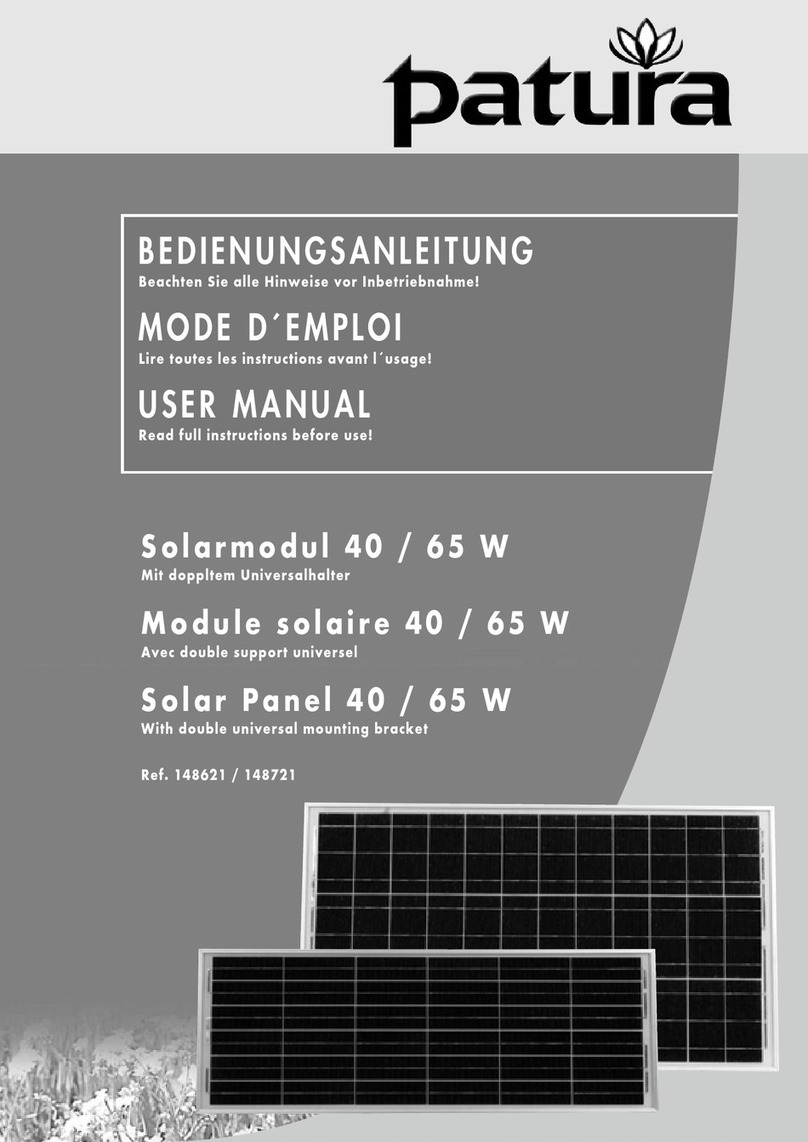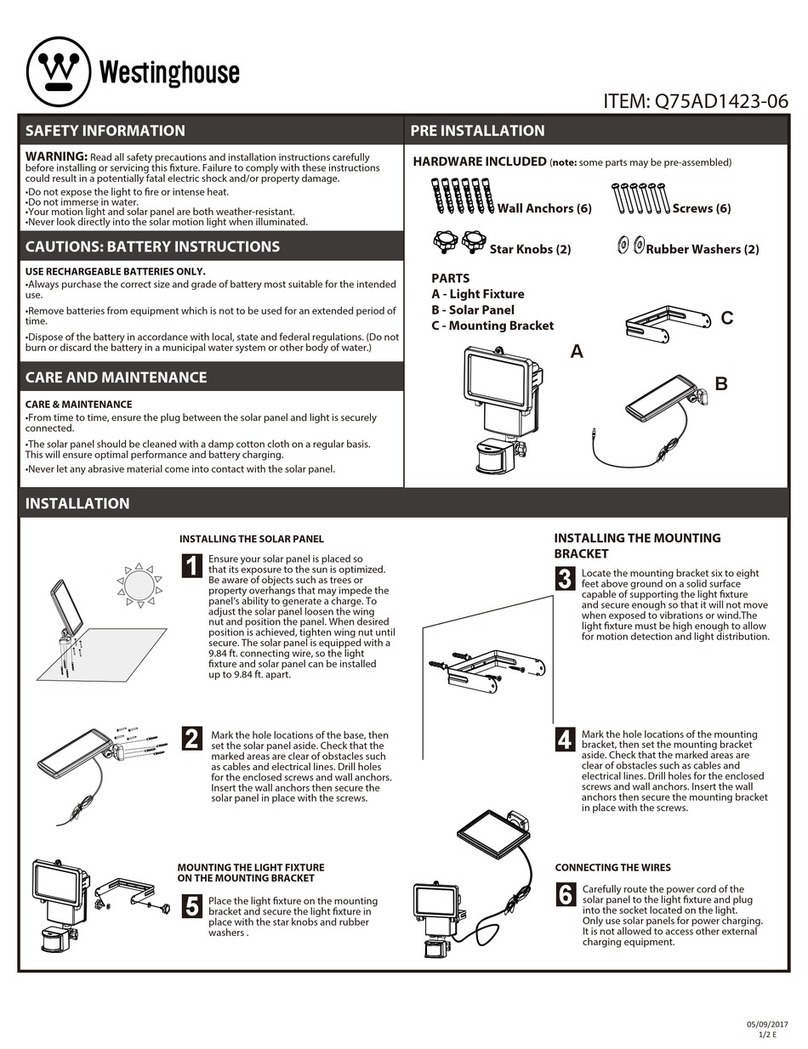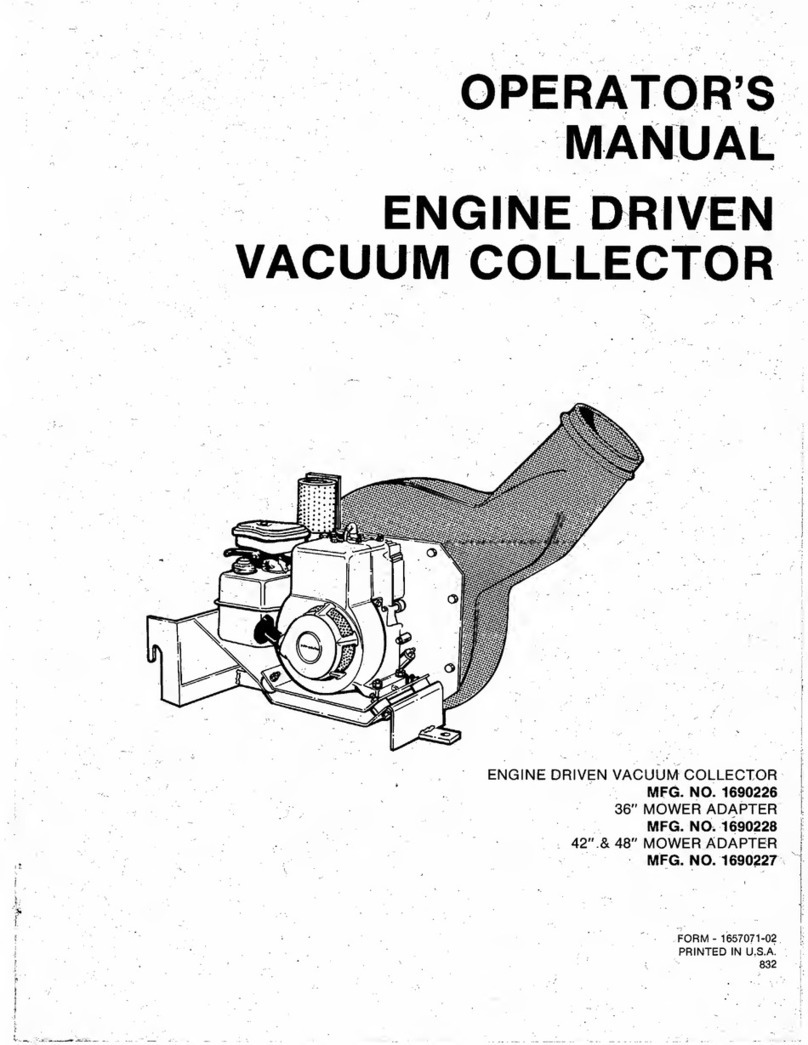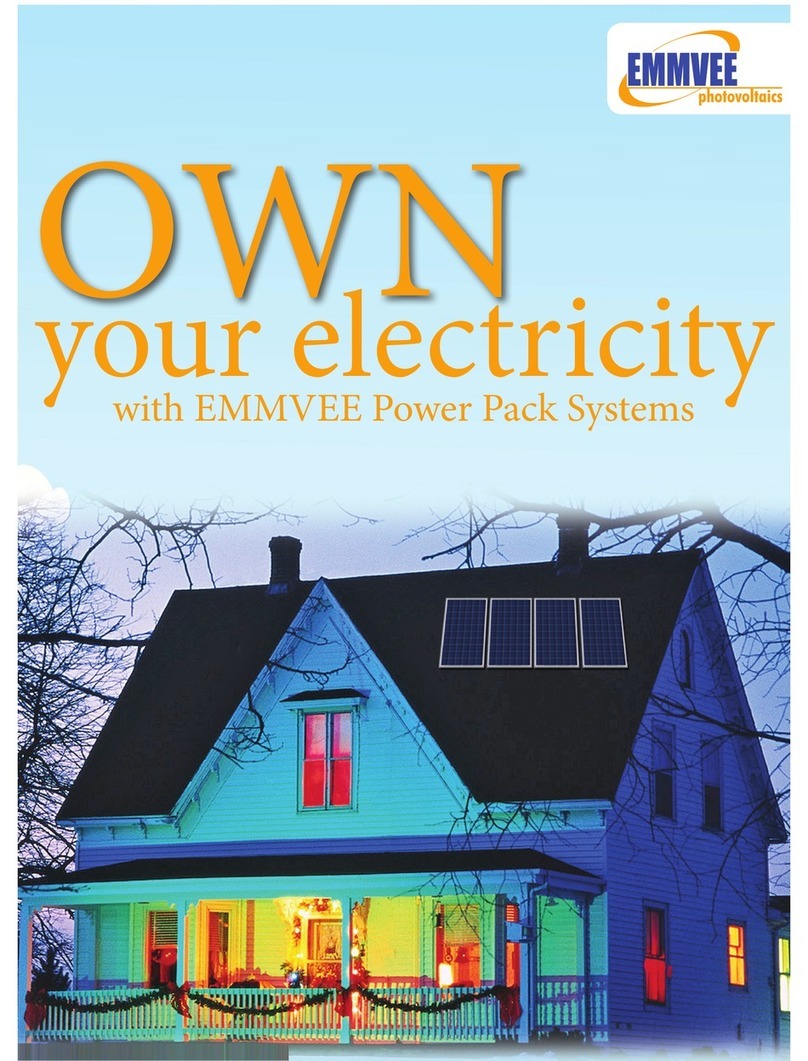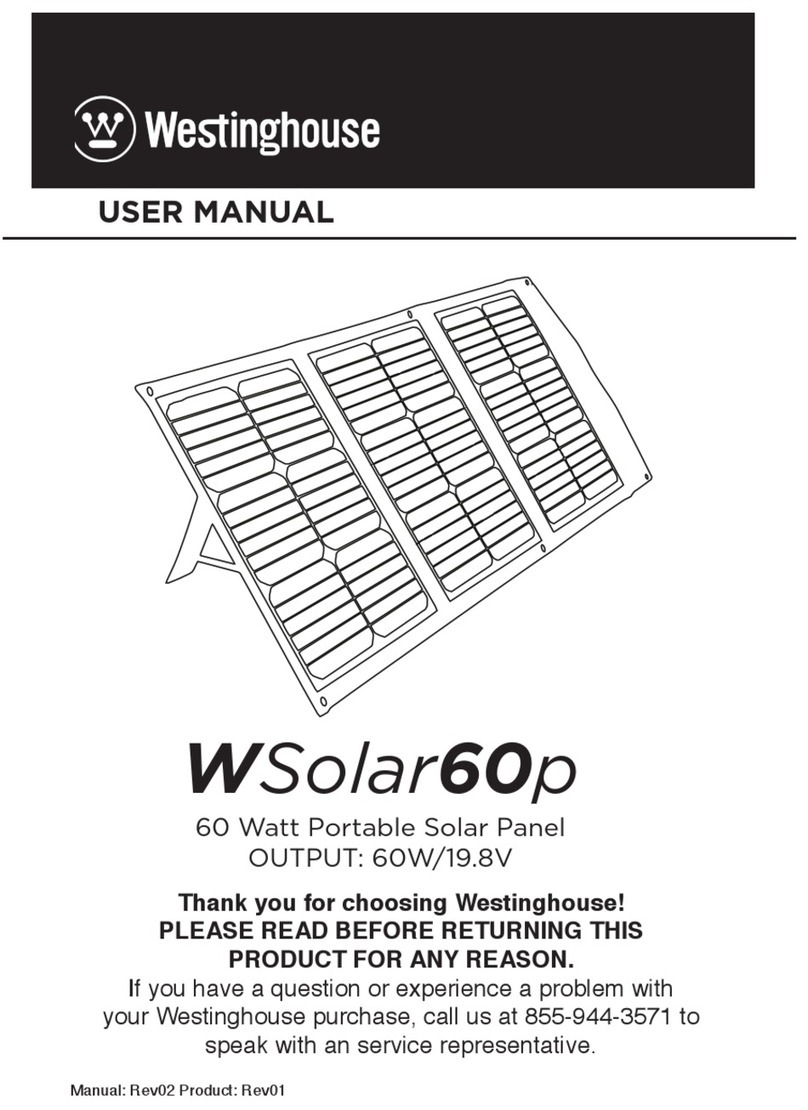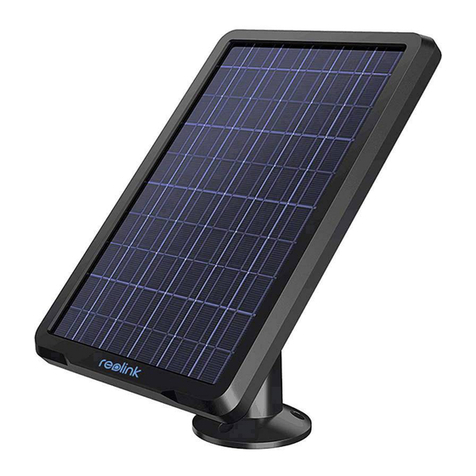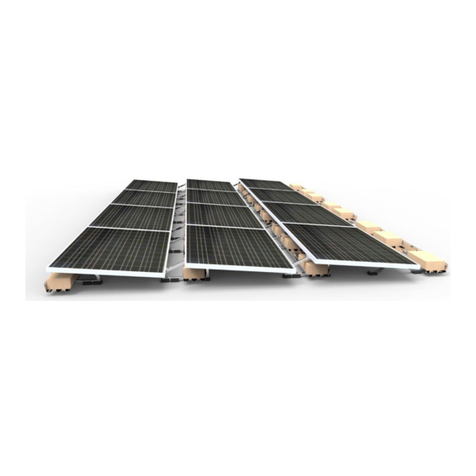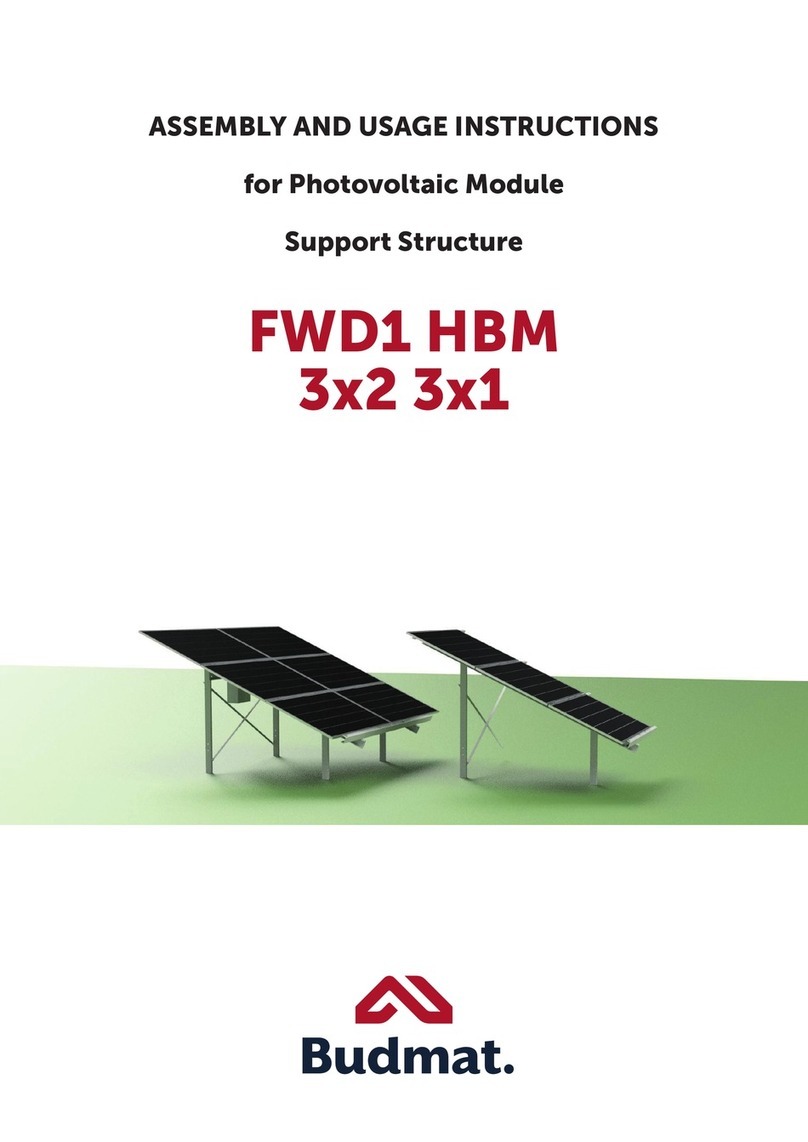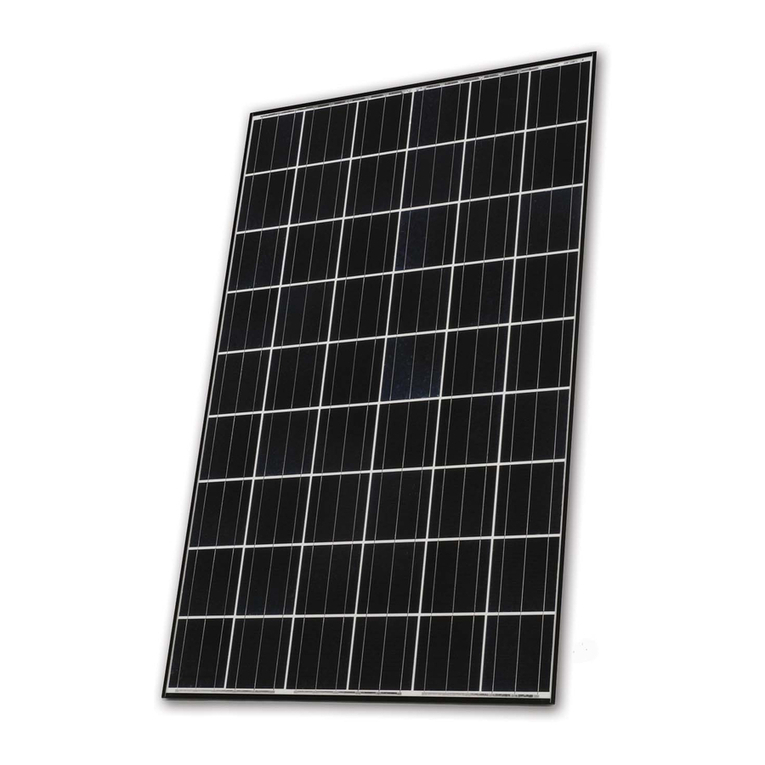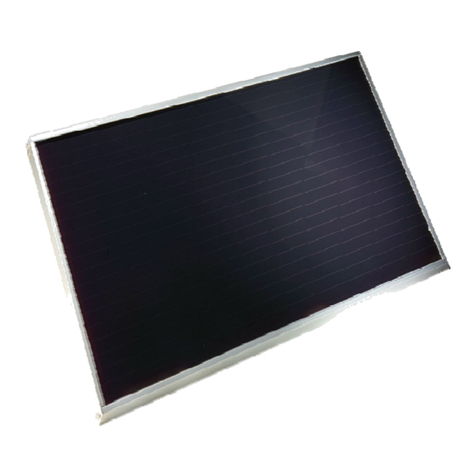Shentai Solar SR10 User manual

SR
Solar thermal collector
INSTALLATION MANUAL
Shentai Solar Ireland Ltd

1.Important
Information
Ensure all flow and return pipes are copper with no plastic connections
Always wear protective gloves and eyewear when handing evacuated tubes
The installation of the solar collectors should no compromise the structural integrity of the
building.
Should the collector be located where is could be vandalized it may be necessary to install
protective guards that do not detract from the collectors performance.
Be careful through when handling the evacuated tubes as they will break if knocked heavily or
dropped onto the hard surfaces.
With the heat pipe installed in the evacuated tube, and good sunlight, the heat pipe condenser can
reach high temperature in excess of 200C. at this moment touching the heat pipe will result in
serious burns.
The evacuated tubes should be insert last after the system has been commissioned, if you wish to
install them all at the same time then cover them up until the pump is on and the system
commissioned.
1.1. Local standards
Installation must be completed in accordance with the relevant local standards and regulations.
1.2.Qualified Installer
Installation must be completed by qualified plumbing professionals.
1.3. Pressure and Temperature Control and Relief.
Solar loop should be designed for normal operation at <500kpa via use of a pressure limiting
(pressure reduction) valve on the mains cold supply line. System design must provide mean for
allowing pressure release at no more than 800kpa (113psi) and hot water dumping from the solar
loop or storage tank once the temperature reaches 99℃(210F). It is recommended that the lever on
the pressure and temperature relief valve (PTRV) be operated once every 6 months ensure reliable
operation. It is important to raise and lower the lever gently.
1.4. Water quality
Water in direct flow through the manifold header must firstly meet potable water requirement and
in addition the following:
Total dissolved solids< 600mg/litre or p.p.m
Total hardness< 200mg/litre or p.p.m
Chloride< 250mg/litre or p.p.m
Magnesium< 10mg/litre or p.p.m
In areas with“hard”water (>200ppm), line scale may from inside in header pipe. In such regions, it
is advisable to in stall a water softening device to ensure the long term efficient operation of the
collector, or use a closed loop for the solar circulation loop. If using a glycol/water must meet the
above requirements, and the glycol must be changed periodically to prevent the glycol from
becoming acidic.
1.5. Metallic corrosion

Both copper & stainless steel are susceptible to corrosion when high concentrations of chloride are
present. The solar collector may be used for heating of spa or pool water, but levels of free chorine
must not exceed 2ppm.in addition the warranty provided on the header when using for spa or pool
heating is 2 years, which is the standard for spa and pool heaters. Chloride level present in most
reticulated pubic potable water supplies are safe for use in the collector provided there is no use of
bore waters in the reticulated supply.
1.6. Freeze Protection
Freeze protection should be in corporate into the system by use of a “low manifold temperature”
setting on the solar controller, which turns on the pump if the manifold drops below a preset level
(eg5℃/41F). Alternatively a closed loop filled with a glycol-water mix may be used to provide
freeze protection. Evacuated tubes are not susceptible to damage in cold weather, and heat pipes
are protected against damage caused by freezing of the water inside.
7. Hail resistance
The glass evacuated tubes are surprisingly strong and able to handle significant impact stresses
once installed. Testing and impact stress modeling proves that the tubes are able to withstand
impact from hail up to 25mm/1’’ in diameter when installed at angle of 40°or greater. The ability of
the evacuated tubes to withstand impact from hail is greater influenced by the angle of impact and
so installing the collectors at low angles do reduce their impact resistance. It is recommended that
in areas prone to large hail (>20mm3/4’’) the solar collector should be installed at an angle of
40”or greater to provide optimum protection. As many populated areas in the world fall within the
latitude of±30-70°this angle is generally a common installation anyway. If in the unlikely
circumstance that a tube should become broken it can be easily replaced in a matter of minutes.
The solar collector can still function properly with one or more broken tubes, however a reduction
in heat output will result (depending upon how many tube are broken).
1.8. System design and installation
Please read all installation instruction carefully before beginning system design or installation. The
system configuration may need to be customized to suit the specific requirements of the
installation. Please ensure that any system design meets local building, water quality regulations.
1.9. Lightning protection
The collectors should be done lightning protecting to avoid the lightning attacking. The lightning
rod is necessary which should be 1.5m higher and 3 m far away from the solar collectors. For any
problems that involve plumbing or electrical connections the services of a qualified professional
must be employed.
2.Unpack and inspect
2.1. Tube inspection
Open the tube box(es), which contain both evacuated tubes and heat pipes. Check to make sure the
evacuated tubes are all intact and the bottom of each tube is still silver. If a tube has a white clear
bottom, it is damaged and should be replaced. Each evacuated tube contains a pair of metal heat
transfer fins. As soon as the evacuated tubes are removed from the box, please put on the rubber

tube caps, which are located in the manifold box. This will protect the bottom tip of the glass tube
from being broken if knocked. Do not remove the and/or expose the tubes to sunlight until you
install them, otherwise the inner tube and heat transfer fin will become very hot. The outer glass
surface will not become hot.
2.2. Heat pipes
If heat pipes are bent during handing, don't worry as they are not easily damaged. Just ensure they
are relatively straight before insertion into the evacuated tube.
2.3. Frame
Unpack the standard frame kit that is packed together with the manifold, if a flat roof frame or low
pitched roof frame is being used, those components will packed separately from the manifold. It
may be necessary to purchase bolts or other fasteners to suit the installation surface.
3. Plumbing
3.1 Plumbing Connection
Once the frame has been mounted and the manifold attached, the manifold header may be
connected to the system plumbing.
3.2 Choice of Piping Material
13mm OD, or 15mm OD copper piping is generally used for most solar collector installations. As
the flow rate is slow, a large diameter pipe is unnecessary and will only increase system costs and
heat loss.
3.3 Pressure Levels
Regardless of the installation configuration, pressure release values, expansion vessels and/or other
pressure control devices must be installed. T he solar loop should be designed to operate at no
more than 800kPa (PRV may be 850kPa). (800kPa =8bar=116psi) For installation where mains
pressure water is used, the system should ideally be designed to operate at a pressure of <500kPa,
achieved by use of a pressure limiting/reduction value.
3.4 Tempering value.
It is recommended, and may be required by regulations, that a temperature control device
(tempering value) be fitted into the hot water pipe between the water heater and bathrooms and
en-suites to reduce the risk of scalding. This is achieved by controlling the water temperature to
below 50℃/122F (temperature may be adjustable).
3.5 Temperature Sensor Insertion
The solar controller's temperature sensor should be coated with a thick layer of thermal paste and
inserted into the sensor port to the full depth. If the fit is too loose, slide a piece of copper plate or
wire in beside the sensor, Seal the sensor port opening with silicone sealant to prevent water
ingress. Ensure that sensors used on the collector are high temperature rated (up to 250℃/486F), in
particular the cable.
3.6. Wind and snow load
When installing the collector please consider the issue of wind resistance and the resultant stress
on the attachment points. the standard frame is designed to withstand wind speeds of up to
120km/h and 30cm snow accumulation without damage. For the areas with possibility for high
winds, additional reinforcement of attachment points may be required and can easily be supplied

by your local installers.
4 Stagnation and Overheating
Stagnation refers to the condition that occurs when the pump stops running, due to pump failure,
power blackout, or as a result of a high tank temperature protection feature built into the controller,
which turns the pump off. If a PTRV is installed on collector inlet or outlet the collector will
continue to increase in temperature until the limit of the temperaure relief valve is reached, at
which point hot water will be dumped from the system. If a PTRV is not installed on the collector,
steam will form in the header. Eventually some steam may feed back to the storage tank via the
return line.
The PTRV on the tank will open to release pressure or heat as required. Under such conditions the
manifold will normally reach a maximum temperature of around 160/320F.. Generally the heat
returning from the collector in the form of steam is not enough to affect a continued increase in
tank temperature (ie. Heat input <tank heat losses)Under normal use stagnation should rarely occur
as a result of pump stoppage, since power blackouts normally happen during storms and not clear
sunny weather. High tank temperature protection should only occur when hot water is notused
for several days (when on holiday), and only during strong periods of sunlight (summer). If leaving
the house for an extended period of time (more than 2-3days), it is advisable to cover the collector
panel or design the system with a heat dissipation device or alternative use for the heat, thus
preventing overheating of the system and collector stagnation. Stagnation of the solar collector will
NOT damage the solar collector, however insulation used on the piping close to the manifold inlet
and outlet should be able to withstand temperatures of up to 200℃/395F.(Eg. Glass wool or
mineral wool-with an exterior wrap of aluminium foil, thus protecting against the elements).

5.Frame Installation
Figure size
model
SR10
SR15
SR20
SR30
A (mm)
810
1190
1570
2320
B(mm)
1995
1995
1995
1995
C (mm)
1720
1720
1720
1720
D(mm)
760
1160
1520
2270
F (mm)
angle
1420/45°
1420/45°
1420/45°
1420/45°
G(mm)
1400
1400
1400
1400
H (mm)
125
125
125
125

1.Measure Roof for bolt holes 2. Drill holes Masonry –8mm
12 tubes ≤885mm
15 tubes ≤1110mm
20 tubes≤1485mm
30 tubes≤2220 mm
Insert Bolt Affix Bolt Firmly to Roof
attach frame on the bolts, two bolt each side of the frame



6.Packing List
Weight of collector (empty without water)
1. SR10-58/1800: 36KG
2. SR15-58/1800: 51KG
3. SR20-58/1800: 70KG
4. SR30-58/1800: 103KG
Pressure drop △p=0.2Kpa (SR20)
△p=0.64Kpa (SR30)

7.Installation collector
7.1. Collector Direction
The collector should face the equator, which if in the Northern hemisphere is due South, and vice
versa. Facing the collector in the correct direction and at the correct angle is important to ensure
optimal heat output from the collector, however a deviation of up to 10°from due North or South is
acceptable, and will have minimal effect
on heat output.
7.2. Collector Angle
It is common for collectors to be installed at an angle that corresponds to the latitude of the
location. Installing at an angle less than 15°is not recommended as the heat pipes perform best in
the range of 15-85 degree While adhering to this guideline ,an angle of latitude +/-10°is acceptable,
and will not greatly reduce solar output. Angles beyond this range may be used, but a decrease in
heat output will result. An angle lower than the latitude will enhance summer output, while a
greater angle will enhance winter output.
7.3. Location
The collector should be positioned as close as possible to the storage cylinder to avoid long pipe
runs. Storage cylinder positioning should therefore consider the location requirements of the solar
collector. The storage cylinder should also be located as close as possible to the most frequent
draw off pipe runs.

8. Maintenance
8.1. Cleaning
Regular rain should keep the evacuated tubes clean, but if particularly dirty they may be washed
with a soft cloth and warm, soapy water or glass cleaning solution, If the tubes are not easily and
safely accessible, high pressure water spray is also effective.
8.2. Leaves
During autumn, leaves may accumulate between or beneath the tubes. Please remove these leaves
regularly to ensure optimal performance and to prevent a fire hazard.(The solar collector will not
cause the ignition of flammable
materials)
8.3. Broken Tube
If a tube is broken it should be replaced as soon as possible to maintain maximum collector
performance. The system will still operate normally even with a tube broken. Any broken glass
should be cleared away to prevent injury.
9. precautions
9.1. Solar for Central Heating-Preventing Overheating
If a system has been designed to provide contribution to central heating, it will often provide much
more heat in the summer than is required for hot water supply alone. In such cases it is advisable
for the home to have a spa or pool that can use the heat in the summer period or a heat dissipation
device be installed.
9.2. Metallic components
Always wear glove when handing the various solar collector components. All efforts have been
made to make the metal components safe to handle, but there may still be some sharp edges.
9.3. Evacuated tubes
Be careful when handing the evacuated tubes, as they will break if knocked heavily or dropped.
Wear gloves if handing any broken glass.
9.4. High temperatures
With the heat pipe installed in the evacuated tube, and
good sunlight, the heat pipe condenser can reach
temperatures in excess of 200℃, At this temperature
touching the heat pipe will result in serious burns, so
please take care when
“experimenting” with, or “demonstrating” the evacuated
tube and heat pipes. In an installed, fully plumbed system,
if the pump is stopped during good sunlight, the collector
header and plumbing pipe close to the manifold can reach
temperatures of 160℃, and therefore caution should be
taken when touching such components.
This manual suits for next models
3
Table of contents


